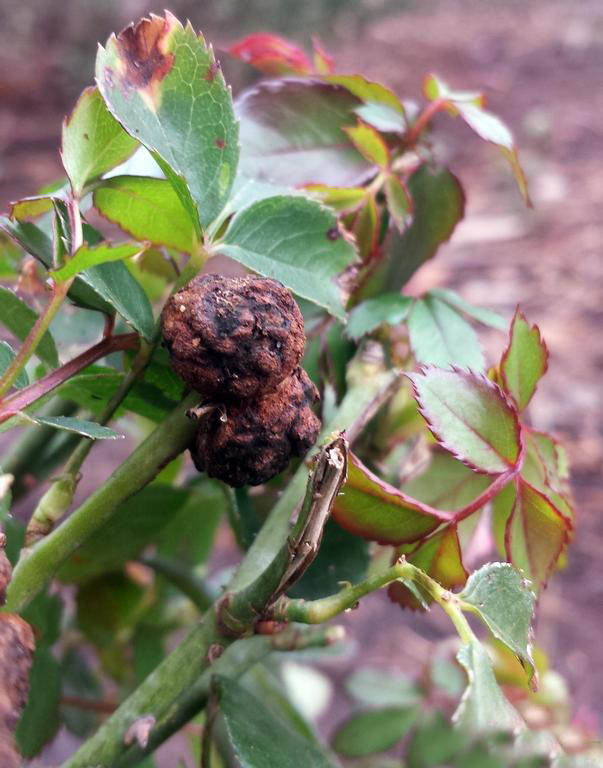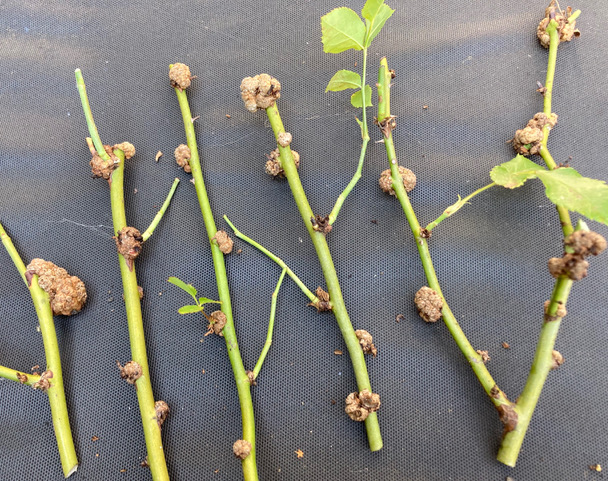Crown Gall causes economic losses on susceptible crops. Agrobacterium tumefaciens causing the disease can travel throughout the root system and can wipe out a crop.

Once the bacteria enter the wounds into the plant it takes about two weeks for the galls to start appearing. The gall cells are not protected by an outer epidermal layer and with time they start cracking and become brittle and start disintegrating. Old galls darken and look rugged and sometimes become infested with insects that feed on the cells. Eventually they fall off back into the soil and are released to start the infection cycle once a host is replanted.
In Kenya Crown Gall is widespread in rose farms. According to growers it is present in almost every rose farm at varied levels.
Strict practices are recommended to keep the disease away from planting materials so as to stop its spread to other rose farms.
Sources of infection & Disease Management
Some infections start from infected soil where a susceptible host is planted. Starting with disease free soil is paramount– through fumigation. One need to ensure usage of clean and treated water is effective and efficient because other infections comes about in irrigation water/recycled water.
It is advisable to use disinfectants to minimize Contamination on pruning equipment. Good sanitation practices helps roughed plants and detached or disintegrated galls back in the soil, the roughed plants should be collected and destroyed by burning.
In the soil the motile bacterial cells respond to the root exudates, the sugars and the amino acids, phenolic compounds like acetosyringone which strongly attract the bacteria especially where the plant tissues have been wounded. The bacteria enter the plants through wounds, to prevent the wound formation ensure that wound causing insects, or nematodes are managed, reduces infection by agrobacterium.
Cultural control methods
Gall removal followed by application of disinfecting paste may prevent the gall regeneration at the treated site but will not stop systemic spread of the pathogen.
Tools used to cut plants should be disinfected between cuts to avoid its spread from one plant to another.
Copper based products are reported to be effective but can be phytotoxic if sprayed directly at the same concentration on the foliage.
The infected part is cut and Copper based fungicides mixture with petroleum gel and applied on the wound.
Biological control
Kerr discovered that non-pathogenic strains of Agrobacterium radiobacter have the ability to compete with pathogenic strains for food and space. A. radiobacter produces an antibacterial compound, (the bacteriocin), that inhibits growth of the pathogen by interfering with the enzymes involved in nopaline production.

Although there are also demerits it acts only as a preventative treatment, not to cure infections, so it is applied at a high population levels to protect any wound sites against pathogenic invasion.
Chemical control
There are few if any effective chemical controls for crown gall, however antibiotics and copper bactericides are able to kill the bacterium on contact, and they do not penetrate the plants and therefore fail to come into contact with bacteria residing systemically. Management of crown gall in nurseries encourage use of substrates for production-Roses grown on substrate like pumice and cocopeat get less affected compared with the soil grown roses.
